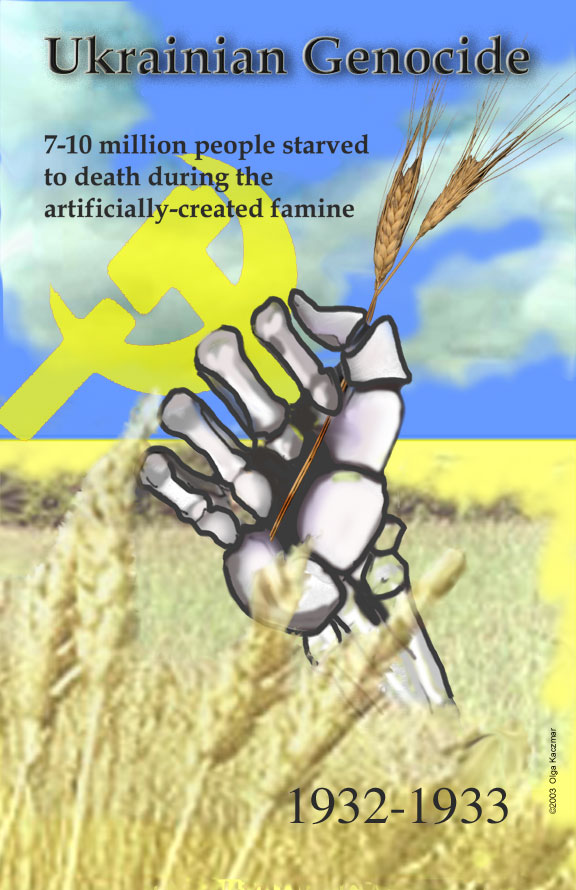 The Holodomor or Holocaust against the Ukrainian people in 1932-33 was a man-made famine engineered by the USSR’s Bolshevik regime that took millions of Ukrainian lives. In all of the history of the human race it would be difficult to find a crime of a similar scale executed with such cruelty and total cynicism and the methods by which it was carried out. While the Soviet Union existed, the topic of the Holodomor was taboo, forbidden to be mentioned. Even the survivors were too terrified to speak of this atrocity in public. It was not until the Ukraine gained her independence in 1991 that the truth about this crime against humanity was brought to national consciousness. The Holodomor has become, for all Ukrainians, the great and tragic symbol of that nation’s suffering as well as the proof of the Ukrainian people’s will and ability to survive.
The Holodomor or Holocaust against the Ukrainian people in 1932-33 was a man-made famine engineered by the USSR’s Bolshevik regime that took millions of Ukrainian lives. In all of the history of the human race it would be difficult to find a crime of a similar scale executed with such cruelty and total cynicism and the methods by which it was carried out. While the Soviet Union existed, the topic of the Holodomor was taboo, forbidden to be mentioned. Even the survivors were too terrified to speak of this atrocity in public. It was not until the Ukraine gained her independence in 1991 that the truth about this crime against humanity was brought to national consciousness. The Holodomor has become, for all Ukrainians, the great and tragic symbol of that nation’s suffering as well as the proof of the Ukrainian people’s will and ability to survive.
Joseph Stalin’s ruthless totalitarian regime was firmly entrenched in Russia by the late 1920s and breaking the spirit of the Ukraine was a priority for the dictator. Stalin was determined to impose his rule and the Ukraine was to be used as “an example to teach the other Soviet republics a lesson.” The Ukraine was to be destroyed and the first group to be liquidated were the intelligentsia and the prosperous farmers. The latter were described as “exploiters” and were to be destroyed, and the lesser farmers were to be collectivized so that the Party could have complete control over the countryside of the Ukraine. Wherever the Party discovered resistance to collectivization, they confiscated all food supplies and banned all travel. Famine, therefore, became the main weapon of mass destruction of the Ukrainian people. The aim was to create conditions that doomed millions of farmers and country dwellers to starvation. The first step was the confiscation of all food resources. The ban on travel was to ensure that the population was totally isolated and unable to escape to search for food. In the autumn of 1932 the government’s actions bore all the marks of genocide as defined by the Article II of the Convention on the Prevention and Punishment of the Crime of Genocide adopted by the United General Assembly on 9th December 1948. Eye witnesses who survived the famine told terrible tales of what occurred:
‘There were five girls and two boys in our family. What little grain we had, father hid in the cattle-shed for sowing. But then the brigades started going from house to house. Our turn came. The brigade broke into our house and told father: “If there is any hidden bread, you’d better tell us, because if we find it, we’ll take away everything to the last kernel.” Our family was large, we were crying, begging them. My father answered there was some barley for sowing. When my father sowed the pit in the cattle-shed with some barley and wheat in the attic, they took away everything and swept the attic with a broom. Famine began. We searched the woods for some berries, but there were more people than berries. There was nothing. Even grass was torn up. What can be said? People were dying every day. Our family was large. So we started going separate ways. Our relatives took my eldest sister to a mine. My mother took away my youngest sister, Varia, and left her near a children’s home in the city of Izium. Later I was also taken to my sister in Donbas. My sister Paraskeva died at home, and Dymtro, born in 1912, walked away somewhere, and I do not know where he is to date. Regarding my mother and father, they starved to death at home.’
Kateryna Stepanivna Pavlenko, Born 1920, Chystovodivka, Izium raion, Kharkiv oblast.
To remember the Holodomor and its victims a large gathering of Ukrainians and their supporters gathered from all over the United Kingdom at the Central Methodist Hall in London, earlier this year, and in the presence of the Ukrainian Ambassador and representative of the Foreign Office heard the testimonies of those who had survived. At this ceremony the son of Malcolm Muggeridge received a decoration from the Ambassador to honour his father, who when he was The Times correspondent in Moscow was the only journalist to report on the horrors happening in the Ukraine. Up to that time Malcolm Muggeridge had been a sympathizer with the Bolshevik Revolution and a Fellow Traveller, but the Holodomor was an eye-opener to him, and led eventually to his reception into the Catholic Church.
Following the gathering in the Methodist Central Hall the participants processed to Westminster Abbey for Evensong and were welcomed by the Dean. The Abbey officials had not bargained on such a huge turnout and the Abbey was packed. The service was followed by a wreath laying ceremony at the Martyrs’ Memorial in the forecourt and the singing of a Panikhida by the Ukrainian Greek Catholic and Ukrainian Orthodox clergy and choirs. The Society was represented by The Revd. Dr. Athanasius McVay and Fr. John Salter and Mr Alan Worsfold and Mr Jonathan Bolton-Dignam.
